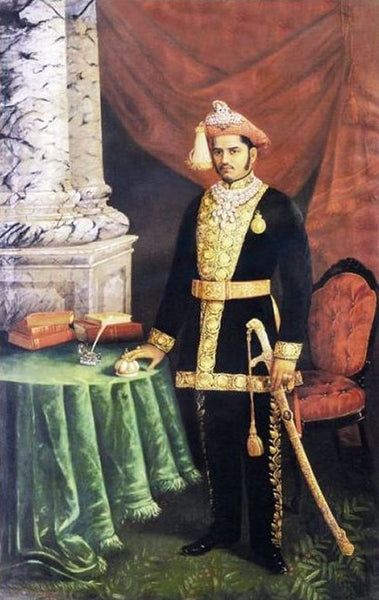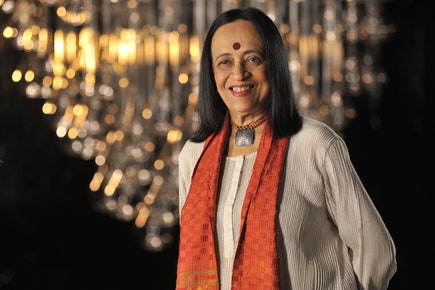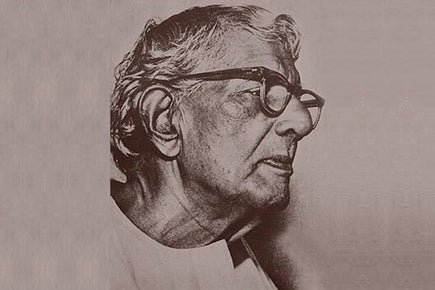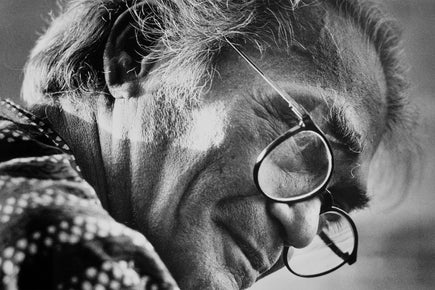15 Things You Need To Know About Raja Ravi Varma
Bringing detail and realism to Indian imagery with a delicate interplay of light and shadows, Raja Ravi Varma is known for his stunning canvasses that have influenced generations of Indian artists.

 (A photograph of Raja Ravi Varma taken in the 1890's)
(A photograph of Raja Ravi Varma taken in the 1890's)
Though a protégé of royalty who was known for his portraits of Kings, Queens and Aristocrats, Raja Ravi Varma was also the first to make lithographs of his artworks affordable and easily available, bringing fine art to the masses.
 (Portrait of Maharaja Sayaji Rao of Baroda by Raja Ravi Varma)
(Portrait of Maharaja Sayaji Rao of Baroda by Raja Ravi Varma)
The first to use European realism and art techniques with Indian subjects, his portrayal of Indian Gods and mythological characters shaped Indian “calendar art”, and greatly influenced Indian literature and the film industry!
 (An oleograph by Raja Ravi Varma depicting the Goddess, Laxmi; click to purchase on Artisera)
(An oleograph by Raja Ravi Varma depicting the Goddess, Laxmi; click to purchase on Artisera)
Here are 15 interesting facts about Raja Ravi Varma that you must know.
1. Ravi Varma was born in 1848 in Kilimanoor, Kerala into a family of scholars, poets and artists. His mother's family followed the matrilineal system of lineage and succession. Therefore, Ravi Varma belonged to the family of his mother, and his children belonged to the family of their mother.
 (Birthplace of Raja Ravi Varma with his studio in the foreground)
(Birthplace of Raja Ravi Varma with his studio in the foreground)
2. When Ravi Varma was a young boy, his uncle recognized his artistic talent, and sent him to the then ruling king, Ayilyam Thirunal, who helped him receive an education in arts, exposed him to western styles of painting, and had him trained by the palace painter.
 (Painting by Raja Ravi Varma depicting the 3rd Duke of Buckingham being greeted by Maharaja Ayilyam Thirunal and Visakham Thirunal of Travancore)
(Painting by Raja Ravi Varma depicting the 3rd Duke of Buckingham being greeted by Maharaja Ayilyam Thirunal and Visakham Thirunal of Travancore)
3. At the age of 18, Varma married 12-year-old Bhageerthi Bayi of the royal house of Mavelikkara. The couple were blessed with two sons and three daughters. One of his daughters, Mahaprabha Amma, features in some of his most famous paintings.
 (A painting by Ravi Varma of his daughter Mahaprabha Amma, with one of her sons)
(A painting by Ravi Varma of his daughter Mahaprabha Amma, with one of her sons)
4. In 1904, Viceroy Lord Curzon, on behalf of the British Emperor, bestowed upon Varma, the Kaisar-i-Hind Gold Medal. The citation for this award mentioned the title 'Raja' for the first time against his name. Varma then continued to use this title much to the consternation of the then Maharaja of Travancore, Sri Moolam Thirunal.

5. The fame of Raja Ravi Varma reached to such great heights, that the small town of Kilimanoor, Varma’s birthplace, had to open a post office, as letters and requests for paintings came flooding in for him from various corners of the country!
 ('Galaxy of Musicians', one of Raja Ravi Varma's most famous works)
('Galaxy of Musicians', one of Raja Ravi Varma's most famous works)
6. During his time, oil painting was a new medium, and it was only artist Ramaswamy Naicker of Madurai who had the knowledge of oil painting techniques. Seeing Raja Ravi Varma as a potential rival, Naicker refused to teach him the technique. It was Arumugham Pillai, Naicker's student, who taught Varma the nuances of oil painting, sneaking into the latter’s house at night, much against the wishes of his teacher.
 (Two of Ravi Varma's popular works: Left - Woman Holding a Fruit; Right - Scene from Kalidasa's 'The Recognition of Sakuntala')
(Two of Ravi Varma's popular works: Left - Woman Holding a Fruit; Right - Scene from Kalidasa's 'The Recognition of Sakuntala')
7. Raja Ravi Varma started a lithographic printing press in 1894, which was eventually sold to a printing technician from Germany. The oleographs produced by the press, mainly depicting gods, goddesses, and scenes from Mahabharata, Ramayana and Puranas, were very popular and continued to be printed in thousands, for many years.
 (Some of Varma's paintings along with the lithography stones used in the press, at the Raja Ravi Varma Archival Museum, Manipal. Image source: indiaheritagevillage.org)
(Some of Varma's paintings along with the lithography stones used in the press, at the Raja Ravi Varma Archival Museum, Manipal. Image source: indiaheritagevillage.org)
 (Ravi Varma's 'Jatayu Vadham', depicting a scene from the Ramayana)
(Ravi Varma's 'Jatayu Vadham', depicting a scene from the Ramayana)
8. In the early 20th century, women from Chettinad, a region in Tamil Nadu, began decorating Ravi Varma’s lithographs with zardozi embroidery and glitter work. These embellished prints included those from the Ravi Varma press and other presses, and can be dated from early to mid 20th century.
 (An embellished oleograph with zari and textile, depicting the 'Shiv Parivaar'; click to purchase on Artisera)
(An embellished oleograph with zari and textile, depicting the 'Shiv Parivaar'; click to purchase on Artisera)
9. Raja Ravi Varma’s brother, C. Raja Raja Varma was an accomplished landscape artist. Most information about the life of Raja Ravi Varma is through ‘The Diary of C. Raja Raja Varma’, written by his brother, who was also Varma’s assistant and business manager.
 (Left: Portrait of C. Raja Raja Varma; Right: The Diary of C. Raja Raja Varma)
(Left: Portrait of C. Raja Raja Varma; Right: The Diary of C. Raja Raja Varma)
10. Raja Ravi Varma was specially commissioned by the Maharaja of Vadodara to create portraits of the royal family and paintings based on Hindu mythology. A large collection of these is still displayed at the Laxmi Vilas Palace, Vadodara.
 (The Laxmi Vilas Palace, Vadodara. Image Source: wall.alphacoders.com)
(The Laxmi Vilas Palace, Vadodara. Image Source: wall.alphacoders.com)
 (Portrait of Maharani Chimnabai of Baroda by Raja Ravi Varma)
(Portrait of Maharani Chimnabai of Baroda by Raja Ravi Varma)
11. In 2013, a crater on Mercury was named ‘Varma’ in his honour!
12. Two of Ravi Varma’s granddaughters were adopted into the royal family of Travancore, and their descendants comprise the royal family, including the present titular Maharajah of Travancore, Rama Varma VII, who ascended the throne in 2013.
 (Chitra Lekha, oleograph by Raja Ravi Varma; click to purchase on Artisera)
(Chitra Lekha, oleograph by Raja Ravi Varma; click to purchase on Artisera)
13. Raja Ravi Varma’s paintings were the inspiration for India’s largest selling comic book series, the Amar Chitra Katha comics!
 (A rare copy of Amar Chitra Katha's 'Malavika')
(A rare copy of Amar Chitra Katha's 'Malavika')
14. In 2014, a film based on the life of Raja Ravi Varma was released, titled Rang Rasiya (Colours of Passion), starring actors Randeep Hooda and Nandana Sen.
 (A promotional poster for the film 'Rang Rasiya')
(A promotional poster for the film 'Rang Rasiya')
15. In 2008, a sari featuring a reproduction of 11 paintings by Raja Ravi Varma, entered the Guinness Book of World Records as the most expensive silk sari. The main highlight of the saree is Varma’s famous ‘Galaxy of Musicians’. Priced at Rs. 40 Lakhs, and weighing 8 kilos, it took 36 skilled craftsmen 12 months to hand-weave this ‘vivaah-patu’ sari!
 (The Vivaah Patu saree, depicting Varma's Galaxy of Musicians)
(The Vivaah Patu saree, depicting Varma's Galaxy of Musicians)
Suffering from diabetes, Raja Ravi Varma breathed his last in October 1906. His artistic lineage continued through his son Rama Varma, who went on to study at the renowned J.J School of Arts, Mumbai. Today, even 110 years after Raja Ravi Varma's death, there is no doubt about the profound legacy left behind by the great artist.

























































































